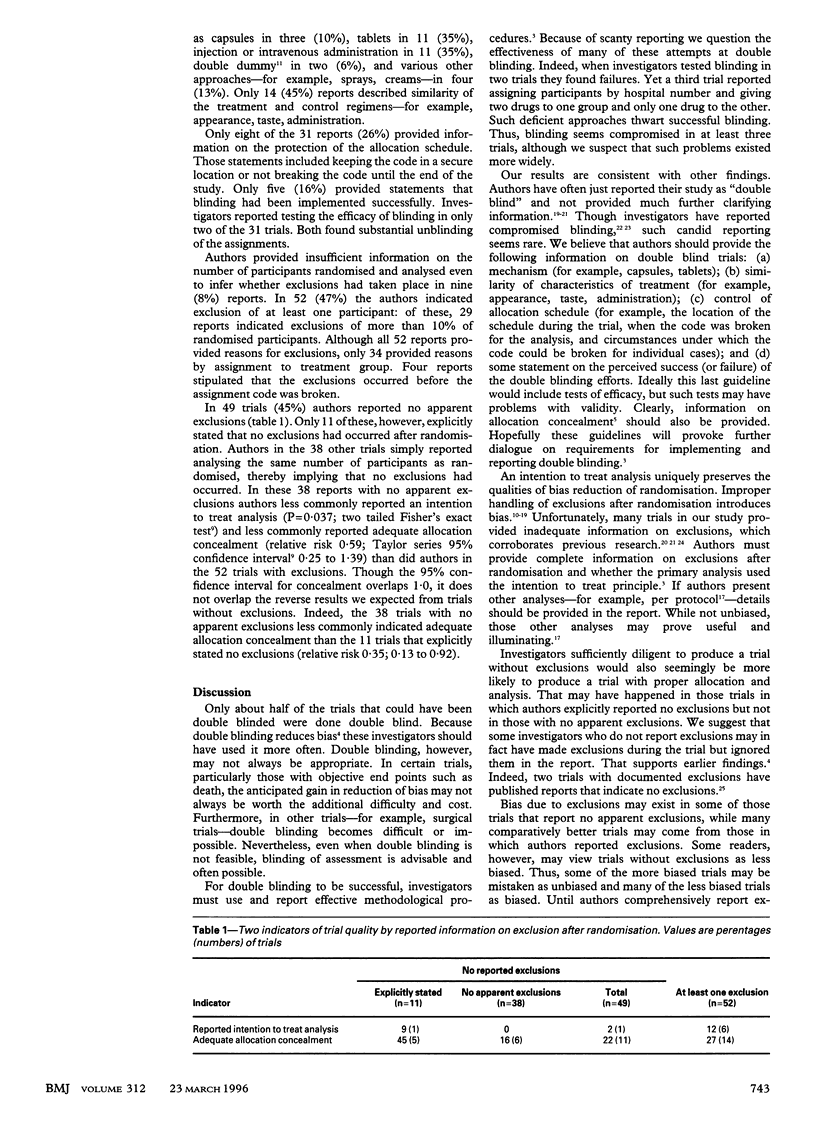Abstract
OBJECTIVE: To assess the methodological quality of approaches to blind ing and to handling of exclusions as reported in randomised trials from one medical specialty. DESIGN: Survey of published, parallel group randomised controlled trials. DATA SOURCES: A random sample of 110 reports in which allocation was described as randomised from 1990 and 1991 volumes of four journals of obstetrics and gynaecology. MAIN OUTCOME MEASURES: The adequacy of the descriptions of double blinding and exclusions after randomisation. RESULTS: Through 31 trials reported being double blind, about twice as many could have been. Of the 31 trials only eight (26%) provided information on the protection of the allocation schedule and only five (16%) provided some written assurance of successful implementation of double blinding. Of 38 trials in which the authors provided sufficient information for readers to infer that no exclusions after randomisation had occurred, six (16%) reported adequate allocation concealment and none stated that an intention to treat analysis had been performed. That compared with 14 (27%) and six (12%), respectively, for the 52 trials that reported exclusions. CONCLUSIONS: Investigators could have double blinded more often. When they did double blind, they reported poorly and rarely evaluated it. Paradoxically, trials that reported exclusions seemed generally of a higher methodological standard than those that had no apparent exclusions. Exclusions from analysis may have been made in some of the trials in which no exclusions were reported. Editors and readers of reports of randomised trials should understand that flawed reporting of exclusions may often provide a misleading impression of the quality of the trial.
Full text
PDF


Selected References
These references are in PubMed. This may not be the complete list of references from this article.
- Altman D. G., Doré C. J. Randomisation and baseline comparisons in clinical trials. Lancet. 1990 Jan 20;335(8682):149–153. doi: 10.1016/0140-6736(90)90014-v. [DOI] [PubMed] [Google Scholar]
- Arnett R. M., Jones J. S., Horger E. O., 3rd Effectiveness of 1% lidocaine dorsal penile nerve block in infant circumcision. Am J Obstet Gynecol. 1990 Sep;163(3):1074–1080. doi: 10.1016/0002-9378(90)91130-5. [DOI] [PubMed] [Google Scholar]
- Chalmers T. C., Levin H., Sacks H. S., Reitman D., Berrier J., Nagalingam R. Meta-analysis of clinical trials as a scientific discipline. I: Control of bias and comparison with large co-operative trials. Stat Med. 1987 Apr-May;6(3):315–328. doi: 10.1002/sim.4780060320. [DOI] [PubMed] [Google Scholar]
- Chalmers T. C., Smith H., Jr, Blackburn B., Silverman B., Schroeder B., Reitman D., Ambroz A. A method for assessing the quality of a randomized control trial. Control Clin Trials. 1981 May;2(1):31–49. doi: 10.1016/0197-2456(81)90056-8. [DOI] [PubMed] [Google Scholar]
- De Jonge H. Deficiencies in clinical reports for registration of drugs. Stat Med. 1983 Apr-Jun;2(2):155–166. doi: 10.1002/sim.4780020209. [DOI] [PubMed] [Google Scholar]
- DerSimonian R., Charette L. J., McPeek B., Mosteller F. Reporting on methods in clinical trials. N Engl J Med. 1982 Jun 3;306(22):1332–1337. doi: 10.1056/NEJM198206033062204. [DOI] [PubMed] [Google Scholar]
- Gøtzsche P. C. Methodology and overt and hidden bias in reports of 196 double-blind trials of nonsteroidal antiinflammatory drugs in rheumatoid arthritis. Control Clin Trials. 1989 Mar;10(1):31–56. doi: 10.1016/0197-2456(89)90017-2. [DOI] [PubMed] [Google Scholar]
- Karlowski T. R., Chalmers T. C., Frenkel L. D., Kapikian A. Z., Lewis T. L., Lynch J. M. Ascorbic acid for the common cold. A prophylactic and therapeutic trial. JAMA. 1975 Mar 10;231(10):1038–1042. [PubMed] [Google Scholar]
- Lewis J. A., Machin D. Intention to treat--who should use ITT? Br J Cancer. 1993 Oct;68(4):647–650. doi: 10.1038/bjc.1993.402. [DOI] [PMC free article] [PubMed] [Google Scholar]
- Meinert C. L., Tonascia S., Higgins K. Content of reports on clinical trials: a critical review. Control Clin Trials. 1984 Dec;5(4):328–347. doi: 10.1016/s0197-2456(84)80013-6. [DOI] [PubMed] [Google Scholar]
- Sackett D. L., Gent M. Controversy in counting and attributing events in clinical trials. N Engl J Med. 1979 Dec 27;301(26):1410–1412. doi: 10.1056/NEJM197912273012602. [DOI] [PubMed] [Google Scholar]
- Schulz K. F., Chalmers I., Grimes D. A., Altman D. G. Assessing the quality of randomization from reports of controlled trials published in obstetrics and gynecology journals. JAMA. 1994 Jul 13;272(2):125–128. [PubMed] [Google Scholar]
- Schulz K. F., Chalmers I., Hayes R. J., Altman D. G. Empirical evidence of bias. Dimensions of methodological quality associated with estimates of treatment effects in controlled trials. JAMA. 1995 Feb 1;273(5):408–412. doi: 10.1001/jama.273.5.408. [DOI] [PubMed] [Google Scholar]
- Sonis J., Joines J. The quality of clinical trials published in The Journal of Family Practice, 1974-1991. J Fam Pract. 1994 Sep;39(3):225–235. [PubMed] [Google Scholar]
- Williams D. H., Davis C. E. Reporting of assignment methods in clinical trials. Control Clin Trials. 1994 Aug;15(4):294–298. doi: 10.1016/0197-2456(94)90045-0. [DOI] [PubMed] [Google Scholar]


